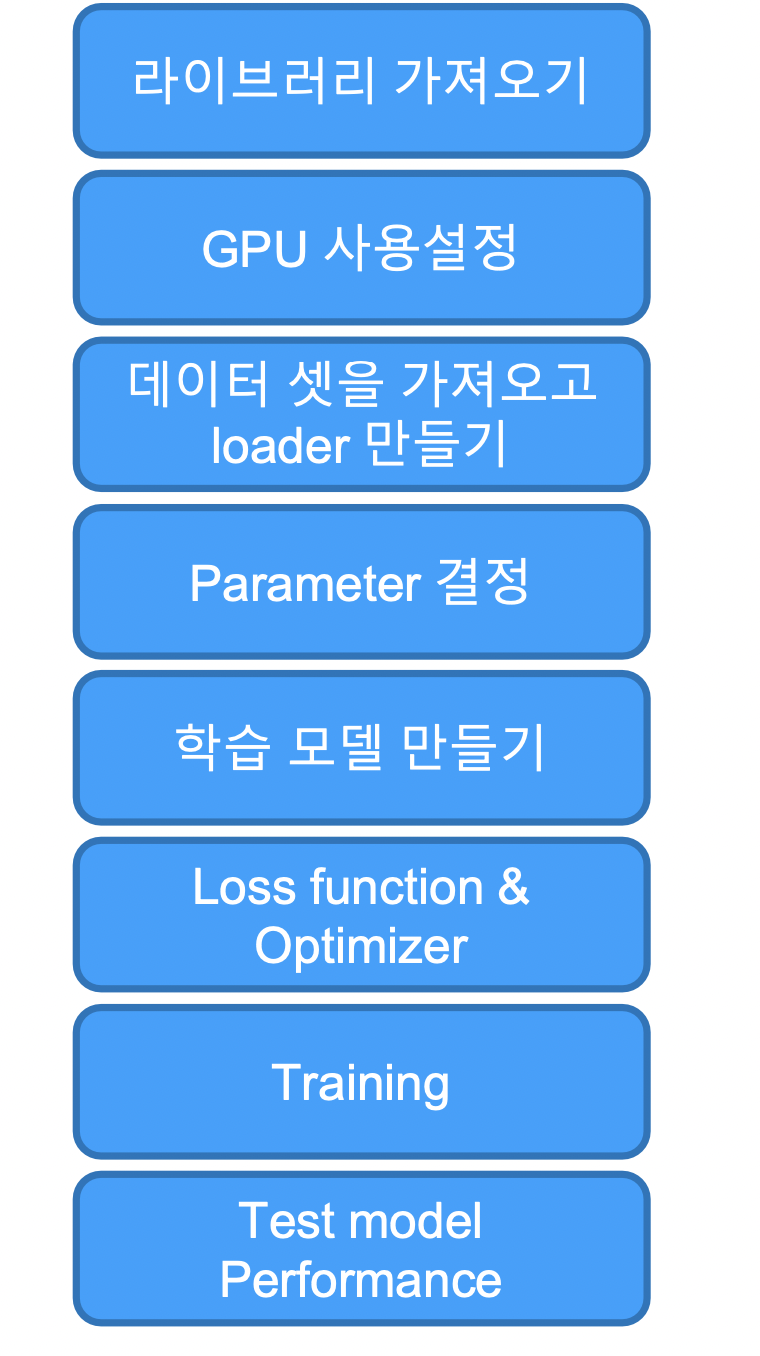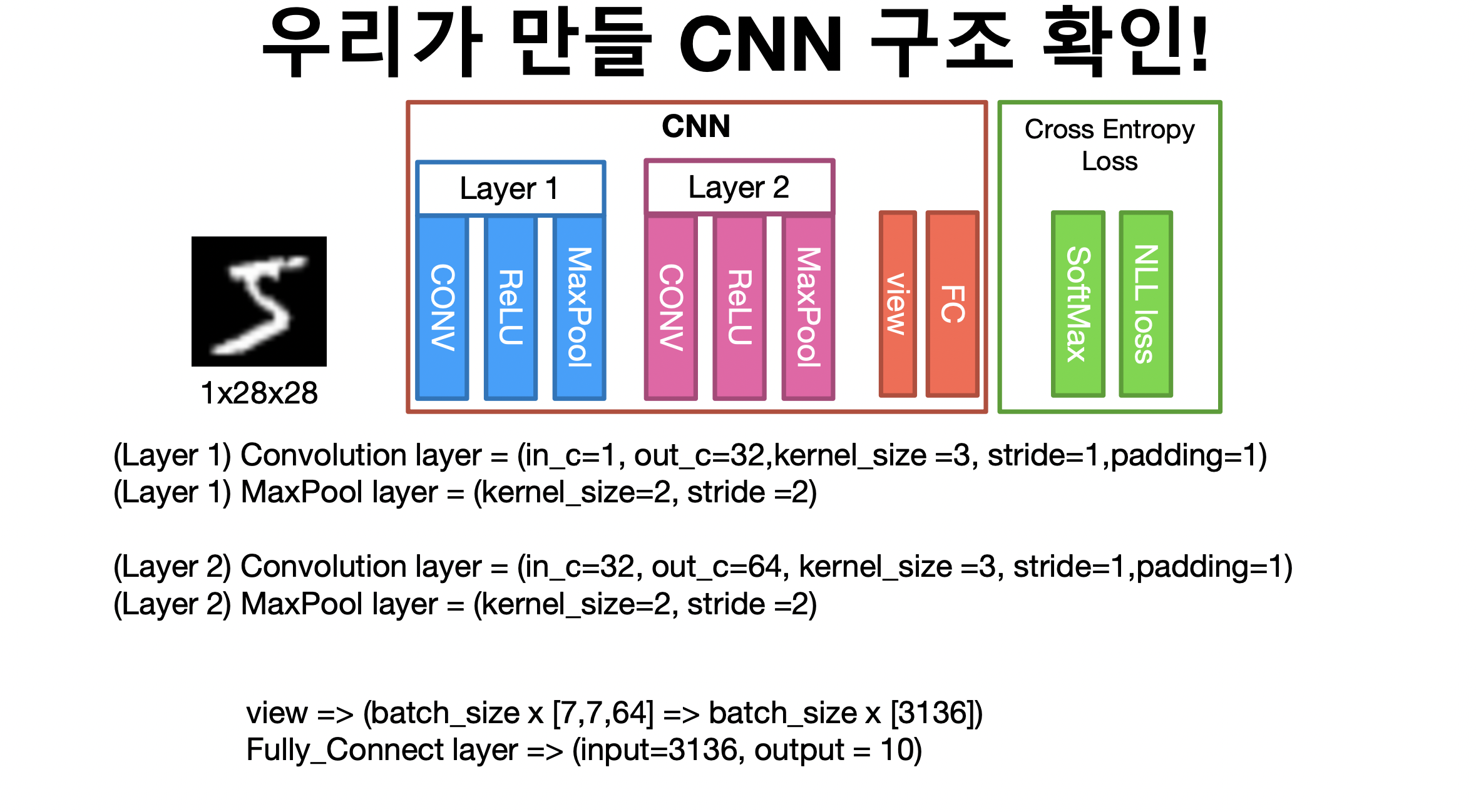딥러닝을 학습시키는 단계
- 라이브러리 가져오고 (torch, torchvision, matplotlib 같은것들)
- GPU 사용 설정 하고 random value를 위한 seed 설정!
- 학습에 사용되는 parameter 설정!(learning_rate, training_epochs, batch_size, etc)
- 데이터셋을 가져오고 (학습에 쓰기 편하게) loader 만들기
- 학습 모델 만들기( class CNN(torch.nn.Module) )
- Loss function (Criterion)을 선택하고 최적화 도구 선택(optimizer)
- 모델 학습 및 loss check(Criterion의 output)
- 학습된 모델의 성능을 확인한다.

CNN 구조 확인

MNIST에 CNN 적용 코드
- 반드시 Layer을 깊게 쌓는다고 해서 CNN이 깊게 쌓이지는 않습니다~!
import torch
import torchvision.datasets as dsets
import torchvision.transforms as transforms
import torch.nn.init
device = 'cuda' if torch.cuda.is_available() else 'cpu'
torch.manual_seed(777)
if device == 'cuda':
torch.cuda.manual_seed_all(777)
learning_rate = 0.001
training_epochs = 15
batch_size = 100
mnist_train = dsets.MNIST(root='MNIST_data/',
train=True,
transform=transforms.ToTensor(),
download=True)
mnist_test = dsets.MNIST(root='MNIST_data/',
train=False,
transform=transforms.ToTensor(),
download=True)
data_loader = torch.utils.data.DataLoader(dataset=mnist_train,
batch_size=batch_size,
shuffle=True,
drop_last=True)
class CNN(torch.nn.Module):
def __init__(self):
super(CNN, self).__init__()
self.layer1 = torch.nn.Sequential(
torch.nn.Conv2d(1, 32, kernel_size=3, stride=1, padding=1),
torch.nn.ReLU(),
torch.nn.MaxPool2d(kernel_size=2, stride=2))
self.layer2 = torch.nn.Sequential(
torch.nn.Conv2d(32, 64, kernel_size=3, stride=1, padding=1),
torch.nn.ReLU(),
torch.nn.MaxPool2d(kernel_size=2, stride=2))
self.fc = torch.nn.Linear(7 * 7 * 64, 10, bias=True)
torch.nn.init.xavier_uniform_(self.fc.weight)
def forward(self, x):
out = self.layer1(x)
out = self.layer2(out)
out = out.view(out.size(0), -1)
out = self.fc(out)
return out
model = CNN().to(device)
criterion = torch.nn.CrossEntropyLoss().to(device)
optimizer = torch.optim.Adam(model.parameters(), lr=learning_rate)
total_batch = len(data_loader)
print('Learning started. It takes sometime.')
for epoch in range(training_epochs):
avg_cost = 0
for X, Y in data_loader:
X = X.to(device)
Y = Y.to(device)
optimizer.zero_grad()
hypothesis = model(X)
cost = criterion(hypothesis, Y)
cost.backward()
optimizer.step()
avg_cost += cost / total_batch
print('[Epoch: {:>4}] cost = {:>.9}'.format(epoch + 1, avg_cost))
print('Learning Finished!')
with torch.no_grad():
X_test = mnist_test.test_data.view(len(mnist_test), 1, 28, 28).float().to(device)
Y_test = mnist_test.test_labels.to(device)
prediction = model(X_test)
correct_prediction = torch.argmax(prediction, 1) == Y_test
accuracy = correct_prediction.float().mean()
print('Accuracy:', accuracy.item())


